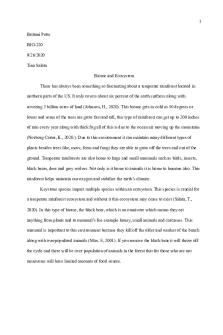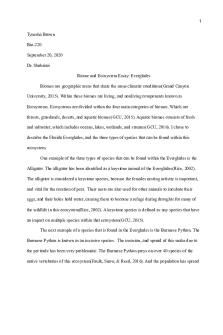Pond Ecosystem SE - Ecosystem file for ponds PDF

| Title | Pond Ecosystem SE - Ecosystem file for ponds |
|---|---|
| Author | Reybin Tejada |
| Course | Valid Huawei H19-301 Dumps |
| Institution | Harvard University |
| Pages | 5 |
| File Size | 330 KB |
| File Type | |
| Total Downloads | 37 |
| Total Views | 158 |
Summary
Pond Ecosystem SE - Ecosystem file for pondsPond Ecosystem SE - Ecosystem file for pondsPond Ecosystem SE - Ecosystem file for pondsPond Ecosystem SE - Ecosystem file for ponds...
Description
Name: ______________________________________
Date: ________________________
Student Exploration: Pond Ecosystem Vocabulary: abiotic factor, biotic factor, concentration, mean, oxygen, parts per million, photosynthesis
Prior Knowledge Questions (Do these BEFORE using the Gizmo.) 1. All animals need oxygen. We get oxygen from the air we breathe. How do fish get theirs? _________________________________________________________________________
2. Where does the “fizz” in soda come from? _______________________________________ _________________________________________________________________________
Gizmo Warm-up The Pond Ecosystem Gizmo™ lets you study ponds as an ecologist would. Each of the tools can be dragged to the pond to take measurements. 1. Drag the Thermometer to the pond at 6:00 AM. What is the water temperature? _______ °C
2. Click Fast-forward ( ) until about 12:00 PM, and then click Pause ( ). What is the water temperature now? _______ °C
3. Just as soda contains dissolved carbon dioxide, pond water contains dissolved oxygen. The unit for measuring the concentration (amount) of oxygen is parts per million (ppm). Drag the Oxygen gauge to the pond. What is the concentration of oxygen? _____________
4. Drag the Fishing pole to the pond, and click Play ( How many catfish did you catch? _____________
). Fish for about four hours. How many trout? _____________
Activity A: A day in the life of a pond
Get the Gizmo ready:
Click Reset (
). Remove the Fishing pole from
the pond.
Introduction: The fish in a pond are affected by biotic factors such as other fish, aquatic plants, insects, and bacteria. They are also affected by abiotic factors, or nonliving factors such as temperature and the concentration of dissolved oxygen. Question: How does the amount of dissolved oxygen in a pond change during one day? 1. Observe: Use the Oxygen gauge to measure the concentration of dissolved oxygen at several different times. How does the oxygen concentration change over a single day? _________________________________________________________________________ _________________________________________________________________________
2. Predict: At what time should the amount of oxygen in a pond be lowest? (Circle one) 6:00 AM
12:00 PM (noon)
6:00 PM
12:00 AM (midnight)
3. Test: Measure the dissolved oxygen at four times during the day: 6 AM, 12 PM (noon), 6 PM, and 12 AM (midnight). Then click New pond and repeat the test for two more ponds. Record your results in the table below. 6:00 AM
12:00 PM
6:00 PM
12:00 AM
Pond 1 Pond 2 Pond 3
4. Analyze: Was your prediction correct for all three ponds? Explain. _____________________ _________________________________________________________________________
5. Draw conclusions: The dissolved oxygen in a pond is produced by pond plants and algae in a process called photosynthesis. A. At what time of day does photosynthesis take place? _________________________ B. What source of energy is present during this time? ___________________________ C. Why does the level of dissolved oxygen go down after sunset? _________________ ___________________________________________________________________
Activity B: Go fish!
Get the Gizmo ready:
Click Reset.
Question: How do concentrations of dissolved oxygen affect fish? 1. Explore: To investigate the question, measure the oxygen concentration and go fishing in several ponds. (To fish, drag the Fishing pole into the pond, click Play, and wait several hours.) Observe the oxygen concentration and the numbers and types of fish you catch.
2. Form hypothesis: How does oxygen concentration affect the fish that live in a pond? ________________________________________________________________________ ________________________________________________________________________
3. Predict: If you fish in four ponds, will more fish be caught in the two ponds with the lowest oxygen concentrations, or the two ponds with the highest oxygen concentrations? Explain. _________________________________________________________________________
4. Test: Investigate four ponds. For each pond, measure the dissolved oxygen concentration at 6:00 AM. Fish for six hours and record how many catfish and trout you catch in each pond. (Hint: To find a pond with relatively high levels of dissolved oxygen, click No farms.) Oxygen (6:00 AM)
Number of catfish
Number of trout
Pond 1 Pond 2 Pond 3 Pond 4
5. Analyze: What does your data show? ___________________________________________ _________________________________________________________________________ _________________________________________________________________________
6. Draw conclusions: Which type of fish can survive better in low-oxygen conditions? Explain. _________________________________________________________________________ _________________________________________________________________________
Activity C: Dissolved oxygen
Get the Gizmo ready:
Select No farms. A calculator is recommended for this activity.
Question: How does temperature affect the concentration of dissolved oxygen?
1. Explore: Measure the temperature and concentration of dissolved oxygen in several ponds. 2. Form hypothesis: How does temperature affect oxygen concentrations? ________________ _________________________________________________________________________
3. Predict: Which ponds will have a higher average oxygen concentration, ponds cooler than 20 °C or ponds hotter than 20 °C? _____________________________________________
4. Test: For each pond, measure the temperature and oxygen concentration at 6:00 AM. If the temperature is below 20 °C, record your results in the left table. If the temperature is above 20 °C, record your results in the right table. Continue until each table is filled. Ponds cooler than 20 °C 6:00 AM Temp.
6:00 AM Oxygen
Ponds hotter than 20 °C 6:00 AM Temp.
6:00 AM Oxygen
5. Calculate: Find the mean (average) oxygen concentration for the cold ponds and for the hot ponds. To find the mean, add the three oxygen concentrations and then divide by three. Mean oxygen level for cold ponds: ________
Mean oxygen level for hot ponds: ________
6. Draw conclusions: How does the temperature of water affect its ability to hold oxygen? _________________________________________________________________________
7. Challenge: Turn off the No farms checkbox. Use the Gizmo to investigate the effect of farms on dissolved oxygen. Record all data on separate sheets. What did you find? _________________________________________________________________________
_________________________________________________________________________...
Similar Free PDFs

Prairie Ecosystem SE
- 4 Pages

Ecosystem report
- 15 Pages

Personal ecosystem for class
- 7 Pages

Copy of Forest Ecosystem SE
- 6 Pages

Ecosystem assignment
- 3 Pages

Ecosystem report
- 14 Pages

Biome and Ecosystem
- 5 Pages

Biome and Ecosystem
- 4 Pages

Biome and Ecosystem Essay
- 3 Pages

Biome and Ecosystem Essay
- 4 Pages

Ecosystem Management Plan
- 4 Pages

Biome and Ecosystem
- 5 Pages
Popular Institutions
- Tinajero National High School - Annex
- Politeknik Caltex Riau
- Yokohama City University
- SGT University
- University of Al-Qadisiyah
- Divine Word College of Vigan
- Techniek College Rotterdam
- Universidade de Santiago
- Universiti Teknologi MARA Cawangan Johor Kampus Pasir Gudang
- Poltekkes Kemenkes Yogyakarta
- Baguio City National High School
- Colegio san marcos
- preparatoria uno
- Centro de Bachillerato Tecnológico Industrial y de Servicios No. 107
- Dalian Maritime University
- Quang Trung Secondary School
- Colegio Tecnológico en Informática
- Corporación Regional de Educación Superior
- Grupo CEDVA
- Dar Al Uloom University
- Centro de Estudios Preuniversitarios de la Universidad Nacional de Ingeniería
- 上智大学
- Aakash International School, Nuna Majara
- San Felipe Neri Catholic School
- Kang Chiao International School - New Taipei City
- Misamis Occidental National High School
- Institución Educativa Escuela Normal Juan Ladrilleros
- Kolehiyo ng Pantukan
- Batanes State College
- Instituto Continental
- Sekolah Menengah Kejuruan Kesehatan Kaltara (Tarakan)
- Colegio de La Inmaculada Concepcion - Cebu



